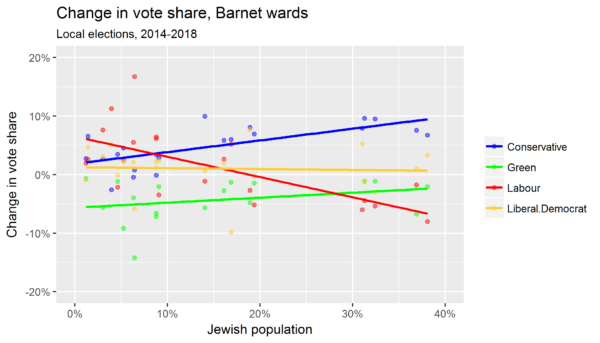Theresa May argues that her party’s success in re-taking control of Barnet Council was a result of Jewish voters ‘reject[ing] the vile antisemitism’ within the Labour Party. Do the numbers back her up? Yes. Just look at the chart above, which is based on ward-by-ward voting figures and the 2011 census. Labour picked up votes only in those parts of Barnet where the Jewish population was low; the more Jews there were within a ward, the more likely it was to lose them instead.
The red trend line falls more steeply than the blue trend line climbs, suggesting that not all Labour’s lost Jewish votes will have gone to the Tories. And in the wards with few Jewish voters, Labour tended to gain about as many votes as the Green Party lost, giving us a clue as to where the votes it picked up came from, and why. But the message here is clear, and much starker than in June, when the ex-Labour vote in Jewish areas seems to have gone to the Liberal Democrats rather than the Tories.
That message is that many left-leaning Jews now see Labour as an institutionally antisemitic organisation that must be kept from power even at the cost of voting for a party on the opposite side of the political spectrum.

All this reflects is that since before Corbyn around 65% of the Jewish vote goes to Tories and 25% to Labour ( BRIN surveys).
Complete nonsense – but that’s all I’d expect from you, given the disinformation you routinely pump out for JVL: an organisation that exists to provide cover for people like Ken Livingstone and whose leading members seem keen to imitate the latter by promoting bizarre and hateful distortions of Holocaust history.
As anyone can see, the chart above shows local election swings from Labour to Tory between 2014 and 2018, just as my earlier analysis showed general election swings from Labour to Liberal Democrat between 2015 and 2017. Obviously those swings cannot reflect the level of Jewish support for Labour ‘since before Corbyn’ because they are swings over a period that in one case mostly overlaps and in the other was almost coterminous with Corbyn’s leadership of the Labour Party.
And since you insist on dragging the honourable name of BRIN into this, here’s its write up of a survey which found that, in 2010, Britain’s Jews were very evenly divided between Labour and the Tories on a political level, with 30-31% support for each.
Alan can’t get his figures from BRIN. The last is from 2010. Plus he’s wrong to say your chart gives the % he quotes.
Pre Corbyn estimates are Tory to Lab of 69% to 22%
https://www.thejc.com/news/uk-news/huge-majority-of-british-jews-will-vote-tory-jc-poll-reveals-1.66001
This 22% diminishes the effect of any exodus of Jewish votes from Labour.
Yes, I’m afraid that Alan (who is apparently a retired biochemist) seems to be making a second career out of talking rubbish. JVL has promoted some of his work.
It’s important to recognise that the Labour Party’s issues with the Jewish community do predate Corbyn – let’s not forget Ken Livingstone, for example, whose history of offensive remarks did not begin with the infamous ‘Hitler supported Zionism’ claim – and the poll you link to is a helpful reminder of that fact. As Dave Rich’s excellent book shows, Corbyn’s emergence as leader must be seen in context of internal Labour Party and broader left wing trends that can be traced back to the 1980s and before. Nick Cohen’s What’s Left? also gives a good account of those trends, and was published nine years earlier. The Jewish community felt all that – especially when Livingstone was mayor.
But Corbyn’s leadership exacerbated the problem by encouraging certain types of ‘socialist’ – notably the various types inclined towards ‘anti-Zionist’ conspiracy theories – to believe that the party belongs to them now, which is why we’ve seen the explosion in Labour antisemitism since 2015. Failure to take action against those responsible has made the problem worse, and led to the consequent further collapse of the Labour vote in Jewish areas (which, as you point out, would have been even more dramatic if it hadn’t already been eroded to such an extent). Perhaps this will be sorted out soon. Perhaps. But the suspicion is that those people haven’t been disciplined because they’re part of the coalition that supported Corbyn in both the last two leadership contests and can be expected to support him again in the event of another challenge.
If the antisemitism problem had been sorted out already, Barnet would be Labour-controlled now. Labour has generally been making progress wherever people voted Remain, and another Jewish Chronicle poll showed that British Jews voted against Brexit by 59-31%.
I realise sample sizes are small, but do you have an R for the Labour curve?
Good question! You’ll note that I also didn’t include intercepts and coefficients as I wanted to keep this post very simple: the regression lines are really just there to make the scatterplot easier to read, and the scatterplot almost speaks for itself. Just by looking at the dots, you can see that, where the Jewish population is greater than 10%, there are no wards where the Conservative Party’s vote share did not rise by more than the Labour Party’s vote share. Whether we model it with a straight line or a curved one, and whether that line is a little steeper or a little flatter, the direction of the overall trend is clear and – given anecdotal evidence from good people like Adam Langleben – would be perverse to ignore. (Although I can see from social media and from comments on this blog that some are doing their best to ignore it.)
I’ll post something with more technical detail later: as you know, statistical modelling takes time, and it’s the weekend. However, since you asked, the R-squared is quite encouraging, at 45% for the Labour vote and 47% for the Conservative vote.